LG washing machine knocks out the machine when turned on
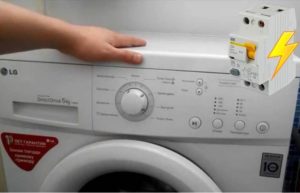 It is unpleasant and dangerous if the washing machine knocks out the machine when turned on. The user does not even have time to select a program and start the cycle: the indicators that just lit up immediately go out, and all the lights in the room turn off. Rebooting will not solve the problem, because there is a clear problem. What is to blame for what is happening and how to eliminate the problem?
It is unpleasant and dangerous if the washing machine knocks out the machine when turned on. The user does not even have time to select a program and start the cycle: the indicators that just lit up immediately go out, and all the lights in the room turn off. Rebooting will not solve the problem, because there is a clear problem. What is to blame for what is happening and how to eliminate the problem?
Electricity or washing machine?
Such a reaction of the wiring when the washing machine is turned on is very dangerous. Firstly, the machine itself is at risk, the control board of which does not like sudden voltage changes. Secondly, due to surges in the network, the insulation of the cores may also suffer, which can lead to a short circuit and fire. Thirdly, the problem itself can have unpleasant consequences - without fixing the problem, there is a high risk of recurrence or worsening of the situation.
Therefore, it is important to immediately understand who is to blame: the machine or the wiring. If the LG washing machine breaks the plugs, you will have to check the main problem areas one by one. There are several possible “sore points”, so with an active warranty, it is better to contact professionals at a service center for diagnostics.
It's another matter when the wiring fails. In this case, you need to call an electrician or independently inspect all power circuits outside the washing machine. Most often, it is in loose contacts that the reason for knocked out plugs lies. We suggest that you do not hesitate and begin diagnostics immediately.
Let's check the wiring
First of all, pay attention to the wiring. Several malfunctions lead to the machine shutting down or knocking out traffic jams at once.
Self-switching off electricity is a necessary measure designed to protect premises from short circuits or current leakage.
- Poor quality, unsuitable or unregulated RCD. The most common problem that leads to a power outage in a room even with a slight network load. The situation can be solved by purchasing a device with a larger capacity, from a trusted manufacturer, or by adjusting the faulty part.
- Disproportionate load on the meter. The wiring is designed for certain powers and if the permissible value is exceeded, an emergency shutdown occurs. For example, not everyone can afford to plug in a refrigerator, washing machine, microwave and electric stove at the same time. There are two ways out: replace the entire electrical network with a more reliable one or operate the devices one at a time.
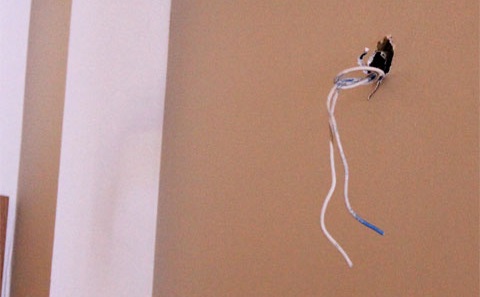
- Damaged network. It is possible that in a certain section of the circuit there was a wire break, a violation of the integrity of the insulation or socket. It’s easy to check the assumption - turn on a device of similar power and look at the machine’s reaction. If the situation repeats, then call an electrician.
As a rule, only professionals solve problems with residential electricity. Working with wires, machines and meters requires high qualifications and a lot of practice. Otherwise, there is a high risk of error, overheating and fire.
Possible problems with the machine
If there are no problems with the supply of electricity to the apartment, then the reason lies in the washing machine. To correct the situation, you will have to disassemble the unit, inspect it and carry out the necessary diagnostics. But before you climb under the body of the washing machine, you should disconnect it from the network and drain the remaining water in the machine through the emergency drain.Otherwise, there is a high risk of electrical or mechanical injury. After taking care of our safety, we study the list of possible problems that lead to the machine turning off:
- damaged power cord or plug;
- caused short circuit of the heating element;
- faulty power filter;
- broken engine;
- broken interference filter;
- non-functional control buttons on the dashboard;
- frayed internal wiring or loose contacts.
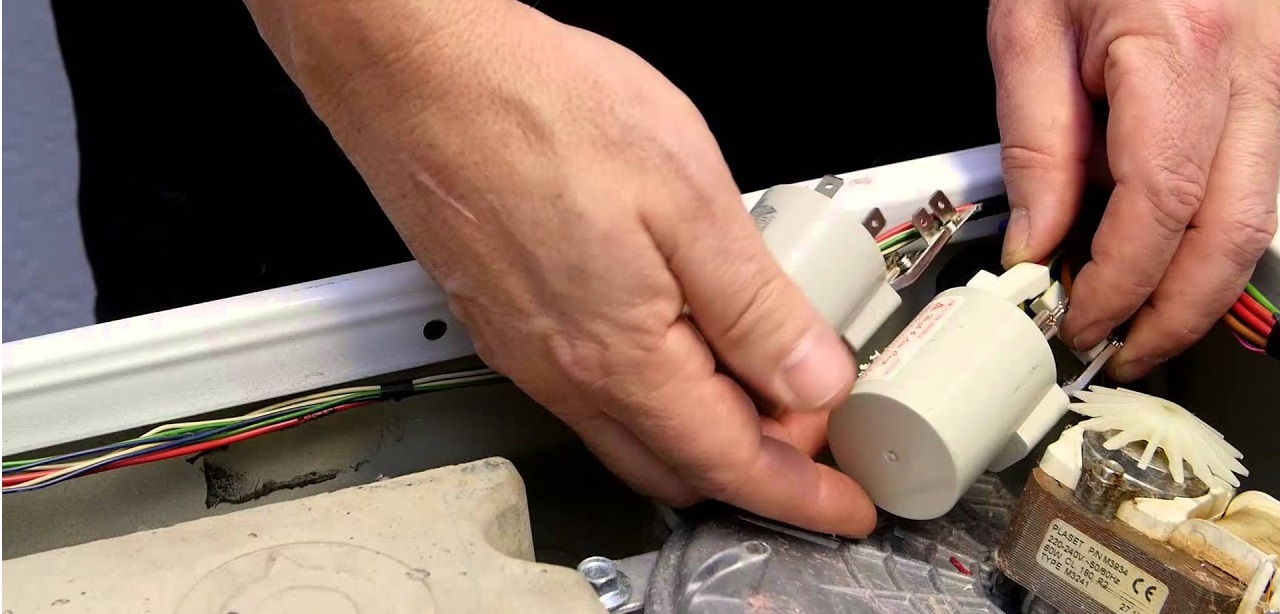
The check should begin with the most frequent and simplest one, moving towards the most costly and less common breakdown. Ideally, it is better to immediately turn to professionals for a comprehensive diagnosis of the machine. But you can do it on your own if you follow the instructions below.
Plug or power cord?
The repair begins with an inspection of the power cord and plug. As a rule, if used incorrectly, the power cord is often stretched, squeezed or tied, which affects the flow of current into the unit. In other words, the plug and socket are not making good contact, and the machine is not able to work at full capacity. It's easy to check the cord - we break it with a multimeter. If damage is detected, replacement will be required.
- Make sure that the machine is disconnected from the power supply.
- Close the inlet valve.
- We drain the water using the emergency drain.
Turning the washing machine over while trying to drain the water is strictly prohibited!
- Unscrew the bolts holding the back panel.
- We find the surge protector and take it out of the machine: press the latches, remove the plastic stopper and squeeze it out of the case.
- Carefully remove the wire from the washing machine.
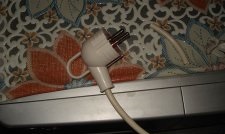
Then all that remains is to purchase a new cord, showing the old one in the store as a sample.Then install the wire in place, following the instructions in reverse order. At the finish, we check the correctness of the work performed by running a test wash.
A heating element
A faulty heating element can also lead to self-shutdown of the machine. Poor quality and too hard water leads to severe scale, accumulation of impurities and chemicals on the heater, which ultimately causes overheating of the element and an internal short circuit. The wiring reacts to the leak by knocking out the meter and plugs.
To check the heating element, disconnect the cord and measure the resistance with a multimeter. We set the limit on the device to 200 Ohms, attach the probes to the contacts and evaluate the result on the display. Normally, the indicator should not exceed 20-50 ohms.
That's not all: it is necessary to exclude external “short circuit”. We alternately measure the outputs on the heating element and the grounding bolts with a multimeter. Normally, the indicator will be zero, since even low values indicate a problem. If there are obvious problems, the heating element should be replaced. You can do this yourself if you follow the following algorithm:
- remove the back panel;
- find the heater;
- unscrew the holding bolt;
- Use a screwdriver to pry up the heating element and remove it.
You must act as carefully as possible. By tightening the nut tightly, it is easy to squeeze the element out of the tank or damage the contacts.
Motor or surge protector?
The power supply filter is responsible for stabilizing the electrical voltage, so it is logical that during fluctuations it reacts by knocking out the RCD. If this happens, the part needs to be replaced. A clear sign will be melted contacts, as well as negative results on the multimeter display.
When an electrical wire is built into the filter, both elements should be replaced.
A short circuit in the wiring on the motor due to prolonged use or a damaged tank or hoses also leads to shutdown. To check, we run the engine with a tester, and if a deviation is detected, we repair or replace it. Worn out electric brushes can fail, but it’s easier here - we remove the old ones and install new ones.
Contacts or wiring?
The electric button, which is often used when operating the unit, is also suspect. In old machines, its condition is immediately visible: if the contacts are worn out or oxidized, then the problem is obvious. We confirm with the multimeter readings, disconnect the panel and wiring, remove the key and install another one.
We also visually look for frayed electrical wires. As a rule, these are found in hard-to-reach places and reveal themselves as carbon deposits on the insulation. To fix it, we solder and strengthen the insulating layer on the wires. “Jokes” with electricity are dangerous to your life and property. Therefore, you cannot ignore the signal from the RCD and try to continue the cycle - it is necessary to find out and fix the problem.
Interesting:
Reader comments
- Share your opinion - leave a comment

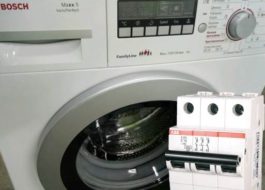



















Add a comment